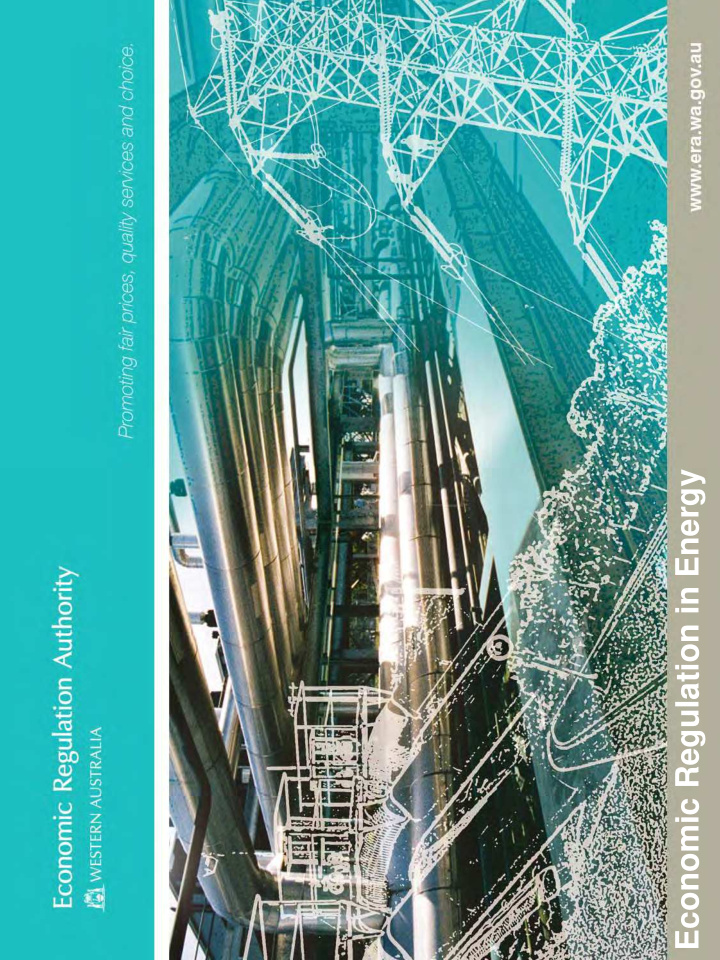



Economic Regulation in Energy
Economics for Sustainability Water Efficiency K Peter Kolf General Manager & CEO Economic Regulation Authority 20 June 2007 Institute for Sustainability & Technology Policy
Overview • The Economic Regulation Authority • Analytical Framework • Water Pricing for Sustainability
The Economic Regulation Authority Functions • Administers Access to Infrastructure • Licenses Service Providers • Monitors & Regulates Markets • Inquiries (Referred by Government) Features • Independent of Government, Industry & Consumer Groups
Economic Regulation Authority Governing Body General Manager Planning & Executive Support Executive Director Executive Director Manager Director Director Gas and Rail References Finance & Competition Access Licensing, and Research Administration Markets & Monitoring & Electricity Customer Protection
Inquiries in the Water Industry 1. Annual Urban Water & Wastewater Pricing May 2007 2. Harvey Bulk Water Pricing May 2007 3. Country Water & Wastewater Pricing July 2006 4. Esperance – Kalgoorlie Bulk Water Supply Nov 2005 5. Urban Water & Wastewater Pricing Nov 2005
Future Inquiries in the Water Industry 1. Competition in the Water & Wastewater Services Sector 2. Developer Charges
Analytical Framework Economic Efficiency Singularity: • Productive efficiency • Allocative efficiency • Dynamic efficiency
Hope for the Future: The Western Australian State Sustainability Strategy Sustainability is defined as: Meeting the needs of current and future generations through an integration of environmental protection, social advancement, and economic prosperity.
Objective Function Maximise: • Needs of current and future generations Subject to: • Environmental protection • Social advancement • Economic prosperity
Economic Prosperity Max W Optimum Environmental Protection
Matters to which the Authority must have regard: • Promote the public interest • Consider the long-term interests of consumers • Encourage investment • Consider the interests of investors & service providers • Promote competition & fair market conduct • Prevent abuse of monopoly power • Practice transparent decision making Section 26 Economic Regulation Authority Act 2003
Objective Function Maximise: • Long term interests of consumers Subject to: • Social advancement • Environmental protection • Economic prosperity • Interests of investors & service providers • Re-elect Minister
Objective Function Maximise: • Re-elect Minister Subject to: • Social advancement • Environmental protection • Economic prosperity • Interests of investors & service providers • Long term interests of consumers
Economic Prosperity Interests of Investors Election of Long Term Interests Minister of Consumers Environmental Protection
Supply of Goods & Services Private Goods Common Property Bread, Butter etc Fisheries, Water resources etc Mixed Goods Public Goods Pipelines, Wires etc Free to air, Defence etc
Monopoly Other monopoly factors: • Economies of scale • Economies of scope • Barriers to entry – infrastructure – legislative (legal)
Externalities • Environmental • Social • Technical
AC 2 Quantity AC 1 MC 1 MC 2 Inclining & Declining Costs Price
First Principles of Intervention • There is a demonstrated need for intervention • It creates the right incentives • It’s least restrictive on consumer sovereignty • It’s benefits outweigh its costs • It’s administratively simple, user friendly & ⇒ It actually works
Types of Intervention (Regulation) • Public sector ownership & control • Price control of private sector • Market based regulation: – Open access – Structural separation – Markets in contestable elements – Artificial markets where possible – Price or revenue cap if all else fails • Monitoring / transparency
Water Pricing for Sustainability Maximise Welfare • Short run marginal cost ? • Long run marginal cost ? • Trade-off
Cost of Water • Average Cost ($0.80/kL) • Long Run Marginal Cost ($1.40/kL) • Bore water & tanks ($1.10 - $3.00/kL) • South West Yarragadee ($1.40/kL) • Water trading (Harvey $0.6/kL) • Recycling ($0.5 - $1.80/kL) • Desalination 2 ($1.75/kL)
Tariff Structures Price MC A + C = B T2 Excess π = 0 C B AR T1 A Quantity q2 q1
Aggregate Distribution of Consuption GL Residential Water Consuption 90 80 Ave Household Consumption = 283 kL 70 60 50 40 Total Consumption = 165 GL 30 20 10 0 0 200 400 600 800 1000 1200 1400 1600 Household Consuption Kilolitres Estimated 2005/06
Urban Residential Tariffs $/kL 1.60 Original Tariff 1.20 0.80 0.40 0.00 0 200 400 600 800 1000 1200 1400 1600 Kilolitres per annum
Urban Residential Tariffs $/kL 1.60 Proposed Tariff Original Tariff 1.20 Service Charge (Original) $152.30 pa 0.80 Service Charge (Proposed) $110.24 pa P Є D 0.40 0.00 0 200 400 600 800 1000 1200 1400 1600 Kilolitres per annum
Water Consumption GL Excess π = 0 Water Company Max W Max π Optimum Number of Connections
Profit 200 100 0 100-200 -100 0-100 -100-0 -200 -200--100 -300--200 -300 -400--300 -500--400 -400 -600--500 -700--600 -500 -800--700 -600 S31 S26 -700 S21 S16 -800 S11 1 3 5 7 9 Water Consumption S6 11 13 15 17 19 21 23 S1 25 27 29 31 33 Number of Connections
Welfare 200 150 100 150-200 50 100-150 50-100 0-50 0 -50-0 -100--50 -50 -150--100 -200--150 -100 31 26 -150 21 16 -200 11 1 3 5 7 9 6 Water Consumption 11 13 15 17 19 21 23 1 25 27 29 31 33 Number of Connections
Concluding Remarks • Is water a special case? • Is there water scarcity? • Does water suffer an allocation problem? • Can water pricing assist? • Are there institutional problems? • Can competition assist? • Can markets assist?
Economic Regulation in Energy
Recommend
More recommend